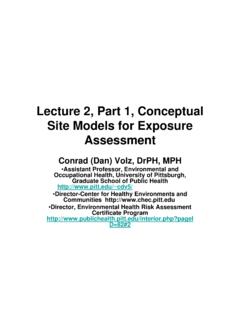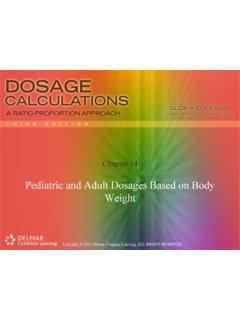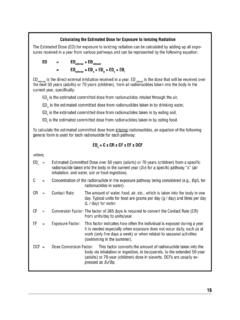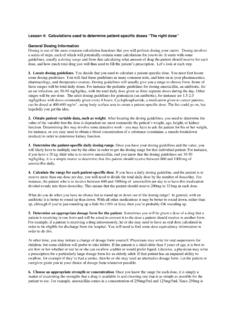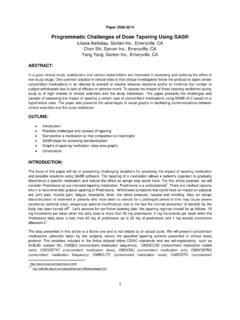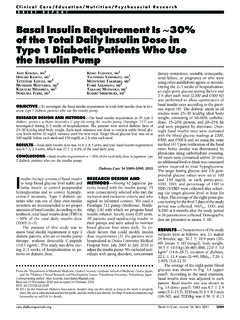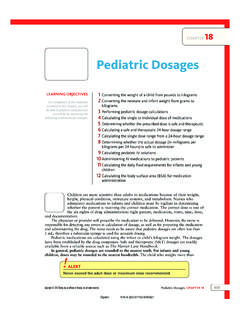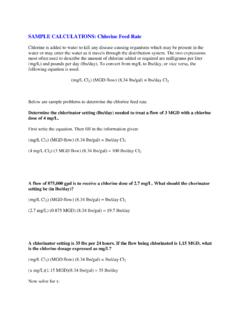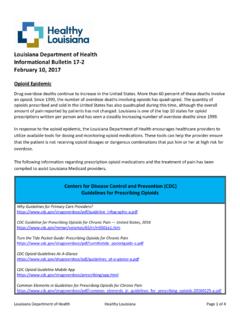Transcription of EOH 2504 Lecture 4 Exposure Assessment Definitions Continued
1 Principals of Exposure Assessment , EOH 2504 Lecture 4 Exposure and dose Defined-Part 2 Conrad Daniel Volz, DrPH, MPHA ssistant Professor, Environmental and Occupational Health, University of Pittsburgh, Graduate School of Public Health ~cdv5/; Director-Center for Healthy Environments and Communities ; Director, Environmental Health Risk Assessment Certificate Program and dose Assessment Relationship to the Environmental Health ParadigmExposure and dose Differences Concentration (mg/M3, ppm {volume or weight}, mg/L, mg/kg) and time (minutes, hours, days, weeks ,months, years, lifetime ) are used to depict Exposure .
2 Amount/Mass (mg, g, g) characterizes dose and addition of time (minutes, hours, days, weeks ,months, years, lifetime ) characterizes the dose of chemical with outer boundary of a personconcentration x time Dermal--(mg chem/L water) (hrs of contact) (mg chem/kg soil) (hrs of contact)Respiratory -(ppm chem in air) (hrs of contact) or ( g/m3 air) (days of contact) Oral--(mg chem/L water) (min of contact) (mg chem/kg food) (min of contact) ExposureE is the magnitude of Exposure , C(t) is the Exposure concentration as a function of time, and t is time, t2 - t1 being the Exposure duration (ED).
3 Exposure estimation by integration and averaging A minimal description of Exposure for a particular route must include Exposure concentration and the duration of contact. If the Exposure concentration is integrated over the duration of contact, the area under the resulting curve is the magnitude of the Exposure in units of concentration multiplied by time ( , mg/litre-day, mg/kg-day, g/m3-h). This is the method of choice to describe and estimate short-term doses, where integration times are of the order of minutes, hours or Exposures vs. Exposure Profiles Integrated exposures are useful when a total Exposure for a particular route ( , the total for various pathways leading to Exposure via the same route) is needed.
4 An Exposure profile (a picture of Exposure concentration over time) contains more information than an integrated Exposure (a number), including the duration and periodicity of Exposure , the peak Exposure , and the shape of the area under the time-concentration curve. Time Weighted Averages Time-weighted averages are widely used in Exposure assessments, especially as part of a carcinogen risk Assessment . Time-weighted average Exposure concentration (units of concentration) is the integrated Exposure divided by the period where Exposure occurs. Time-weighted average dose rate is the total dose divided by the time period of dosing, usually expressed in units of mass per unit time, or mass/time normalized to body weight ( , mg/kg/day).
5 Time-weighted average dose rates such as the lifetime average daily dose (LADD) are often used in dose -response equations to estimate effects or calculate risk. Potential DoseAmount of a chemical contained in material ingested, air breathed, or bulk material applied to the skin. The concept of potential dose isstraightforward for inhalation and ingestion, where it isanalogous to the dose administered in a dose -response experiment. For the dermal route, however, it is important to keep in mind that potential (or administered) dose refers to the amount of the agent, whether in pure form or as part of a carrier medium, that is applied to the surface of the of the chemicalDose rate is mass of the chemical/time.
6 The dose rate is sometimes normalized to body weight: mass of chemical/unit body weight time Dermal---(mg chem/kg soil) (kg soil on skin) = mg chem in soil applied to skin Respiratory---( g chem/m3 air) (m3 air breathed/min) (min exposed) = g chemical in air breathed Oral---(mg chem/L water) (L water consumed/day) days exposed = mg chemical ingested in water(also dose rate: mg/day)Potential DoseMost Common dose MeasureAverage daily dose (ADD)ADD= C * IR * B* D/ BW* ATADD= Potential average daily Body weight (kg).B= BioavailabilityD= DurationIR= Ingestion RateC= Mean Exposure concentrationAT= time period over which the dose is averaged (days)Example ADD Calculation Assume the quantity of lettuce ingested is week/ daily maximum kg.
7 Aldrin pesticide is 4 ppm. Calculate the ADD of Aldrin for the maximum week, assuming the bioavailability is 90%. ADD= C * IR * B* D/ BW* AT C= 4mg/kg Aldrin BW= 70 kg AT= 7 days IR= B= IR B D BW ATSo ADD= (4mg Aldrin /kg lettuce)( lettuce)( ) (1 week)/ (70 kg) (7 days/week )ADD= mg Aldrin/ kg-dayLifetime average daily dose (LADD) carcinogensLADD=C* IR*B*D/BW*LTBW= Body weight (kg).B= BioavailabilityD= DurationIR= Ingestion RateC= Mean Exposure concentrationLT= Life time-70 year or 25,550 daysCalculate the LADD given the same levels in the ADD exampleLADD=C* IR*B*D/BW*LTBW= 70 kgB=.
8 9 mg Aldrin absorbed/1 mg ingestedD= Duration= 70 yearsIR= kg/wkC= 4 mg Aldrin/kg lettuceLT= Life time-70 year or 25,550 daysLADD= 4 mg Aldrin/ kg lettuce* ( kg lettuce ingested/week* 52 weeks/ year)* 70 years/ lifetime * .9 mg lettuce bioavailability/ 1mg lettuce ingested CIRDB70 kg * 25,550 days/lifetimeNumerator must be potential dose in this case so it must be in units of mass mg Aldrin, everything else must cancel outSince we are interested in average daily dose rate normalized to body weight the denominator must be in units of kg-body 19,656 mg Aldrin/1,788,500 kg-day= mg Aldrin/ kg-dayApplied DoseAmount of chemical in contact with the primary absorption boundaries ( , skin, lungs, gastrointestinal tract)
9 And available for absorption Information is rarelyavailable on applied dose , so it is calculated from potentialdose based on factors such as bioavailabilitymass of the chemicalDose rate is mass of the chemical/time; the dose rate is sometimes normalized to body weight: mass of chemical/unit body weight time Dermal----(mg chem/kg soil) (kg soil directly touching skin) (% of chem in soil actually touching skin) = mg chem actually touching skin Respiratory-- ( g chem/ m3 air) (m3 air directly touching lung) (% of chemical actually touching lung) = mg chemical actually touching lung absorption barrier Oral-- (mg chem/kg food) (kg food consumed/day) (% of chemical touching tract) = mg chemical actually touching tract absorption barrier(also absorbed dose rate.)
10 Mg/day) chemical available to organ or cell Applied DoseInternal(Absorbed ) DoseThe amount of a chemical penetrating across an absorption barrier or exchange boundary via either physical or biological processes. mass of the chemicalDose rate is mass of the chemical/time; the dose rate is sometimes normalized to body weight: mass of chemical/unit body weight time Dermal-mg chemical absorbed through skinRespiratory-mg chemical absorbed via lung Oral--mg chemical absorbed via tract ( dose rate: mg chemical absorbed/day or mg/kg day) Internal (Absorbed ) DoseDelivered DoseAmount of chemical available for interaction with any particular organ or cell.


